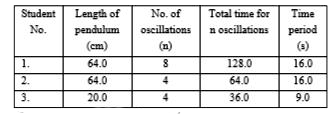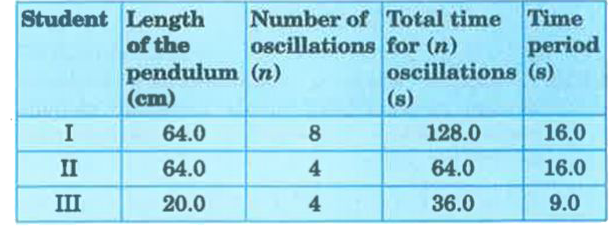Students I1,J1,J3 and I2 perform an experiment for measuring the acceleration due to gravity (g) using a simple predulum, they use different lengths of the pendulum and record time for different number of oscillations. The observations are shown in the table. Least count for length =0.1cm, least count for time = 1s
StudentsLength of thependulum (cm)No.ofoscillations(n)Time periodof pendulum (s)I1100.02020J1400.01040J1100.01020I1400.02040
If P1,P2,P3 and P4 are the % error in g for students I1,J1,J3 and I2 respectively then -
P1=P3
P3 is maximum
P4 is minimum
Pa=P4
The correct Answer is:B, C
T=2π√lg⇒g∝lT−2=Δgg=Δll+2ΔTT
Therefore P=(Δll+2ΔTT)100⇒P1=(0.1100+2(1)400)×100=0.6%−P2=(0.1400+2(1)400)×100=0.42%
P3=(0.1100+2(1)200)×100=1.1%,P4=(0.1400+2(1)800)×100=0.28%.
Topper's Solved these Questions
- BOOK - ALLENCHAPTER - ERROR AND MEASUREMENTEXERCISE - Part-2(Exercise-1)51videos
ERROR AND MEASUREMENT
- BOOK - ALLENCHAPTER - ERROR AND MEASUREMENTEXERCISE - Part-2(Exercise-2)(A)16videos
ERROR AND MEASUREMENT
- BOOK - ALLENCHAPTER - ELASTICITY, SURFACE TENSION AND FLUID MECHANICSEXERCISE - Exercise 5 B (Integer Type Questions)3videos
ELASTICITY, SURFACE TENSION AND FLUID MECHANICS
- BOOK - ALLENCHAPTER - KINEMATICSEXERCISE - Integer Type Question3videos
KINEMATICS
Similar Questions
Three students S1,S2andS3 perform an experiment for determining the acceleration due to gravity (g) using a simple pendulum. They use different lengths of pendulum and record time for different number of oscillations. The observations are as shown in the table.

(Least count of length = 0.1 m least count for time = 0.1 s)
If E1,E2andE3 are the percentage errors in 'g' for students 1, 2 and 3 respectively, then the minimum percentage error is obtained by student no._____.View SolutionIn an experiment to measure the time-period of a simple pendulum, the time for 20 complete oscillations was found to be 36 s. What is the time-period of this pendulum ?
View Solution
Knowledge Check
- Question 1 - Select One
Student I, II and III perform an experiment for measuring the acceleratioon due to gravity (g) using a simple pendulum . Theu use different lengths of the pedulum and /or record time for different number of oscillations . The observation are shoen in the table .
Least count for length =0.1cm
Least count for time =0.1s

If EI, EIIand EIIIare the percentage errors in g,i.e
Δgg×100for students I, II, and III respectively ,AEI=0BEI is minimumCEI=EIIDEII is maximum - Question 2 - Select One
Student I,II,andIII perform an experiment for measuring the acceleration due to gravity (g) usinf a simple pendulum. They use lengths of the pendulum and // or record time for different number of oscillations . The observations are shown in the following table . Least count for length =0.1cm
StudentIIIIIILength of Pendulam(cm)64.064.020.0Number ofn Oscillation(n)844TimePeriod(s)16.016.09.0
Least count for time =0.1s.
If EI,EII , and EIII are the percentage errors in g , i.,e., (Δgg×100) for students I,II , and III, respectively , thenAEI=0BEIisminiμmCEI=EIIDEIIismaxiμm - Question 3 - Select One
While measuring acceleration due to gravity by simpe pendulum a student makes a positive error of 1% in the length of the pendulum and a negative error of 3% in the value of the time period. His percentage error in the measurement of the value of g will be -
A2%B4%C7%D10%
T0 is the time period of a simple pendulum at a place. If the length of the pendulum is reduced to 116 times of its initial value, the modified time period is :
View SolutionThe acceleration due to gravity at a place is π2m/s2. Then, the time period of a simple pendulum of length 1 m is
View SolutionThe time period of a simple pendulum is 1.2 s. If the length of the pendulum is doubled, the new time period will be
View SolutionThe time period of a simple pendulum is 1.2 s. If the length of the pendulum is doubled, the new time period will be
View SolutionA student uses a simple pendulum of exactly 1 m length to determine g, the acceleration due to gravity. He uses a stop watch with the least count of 1 s for this and records 40 s for 20 oscillations. For this observation, which of the following statements is true?
View Solution

